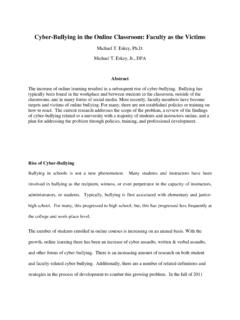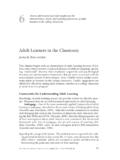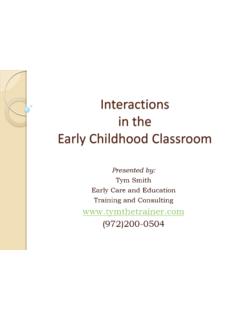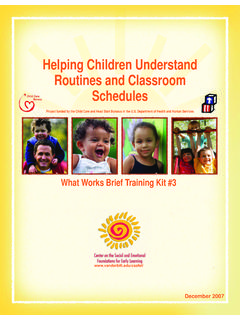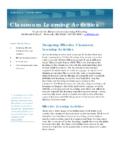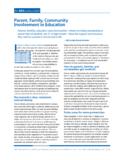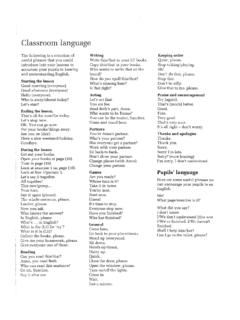Transcription of Problem-Based Learning in the Student Centered …
1 Problem-Based Learning in the Student Centered classroom by Jeffrey R. Utecht March, 2003. Abstract The following paper discusses implementing Problem-Based Learning in the Student - Centered classroom . The paper focuses on the use of Problem-Based Learning as a tool in the Student - Centered classroom . It looks at the history of Problem-Based Learning , the implementation of Problem-Based Learning into the classroom , and the role technology plays in a Student - Centered environment and the opportunities it provides for Problem-Based Learning . Table of Contents Table of Contents ii Introduction 1.
2 A Student - Centered classroom 1. History of Problem-Based Learning 3. The Worker of Tomorrow 5. Problem-Based Learning 6. Implementing Problem-Based Learning in the Student - Centered classroom 9. The Use of Technology 14. Conclusion 15. References 16. ii Problem-Based Learning in the Student - Centered classroom Introduction Education today is changing from one of factual based to one of inquiry based. This new approach to Learning is bringing about new ways in which students are involved in the Learning process. Teachers know that students do not learn at their highest potential when they are in a classroom where the teacher stands at the front of the room and gives them knowledge.
3 Students learn best when they are engaged in the Learning process and discover for themselves the meaning of knowledge (Gentry, 2000, pg. 3). Problem-Based Learning (PBL) in the Student - Centered classroom gives students the chance to discover knowledge in a meaningful and applicable way. This paper will examine PBL in the Student - Centered classroom . It will begin by defining Student - Centered . Secondly, it will look at the history of PBL and the skills that are going to be required by workers in the future. Next, it will define PBL and give a brief explanation of the design, implementation and assessment process of Problem-Based Learning in a Student - Centered environment.
4 Finally, it will examine how technology plays an important role in both the Student - Centered environment and PBL. A Student - Centered classroom A Student - Centered classroom is defined as a classroom where the students are actively involved in the Learning process. This is a classroom where the focus is not on the teacher PBL in the Student - Centered classroom 2. teaching, but rather the Student Learning (unknown, ). Combs (1976) states that three characteristics are needed in creating an effective Learning environment: 1. The atmosphere should facilitate the exploration of meaning.
5 Learners must feel safe and accepted. They need to understand both the risks and rewards of seeking new knowledge and understanding. The classroom must provide for involvement, interaction, and socialization, along with a business-like approach to getting the job done. 2. Learners must be given frequent opportunities to confront new information and experiences in the search for meaning. However, these opportunities need to be provided in ways that allow students to do more than just receive information. Students must be allowed to confront new challenges using their past experiences without the dominance of a teacher/giver of information.
6 3. New meaning should be acquired through a process of personal discovery. The methods used to encourage such personal discovery must be highly individualized and adapted to the learner's own style and pace for Learning . These three characteristics are at the heart of the Student - Centered classroom . Students need to feel safe in order to take the risk in discovering new knowledge. They must feel secure in facing challenges based on past experiences. They must be given the opportunity to find information on their own in a way that is relevant to them. In a Student - Centered environment, students move away from following orders given by a teacher to self-directed Learning activities, from memorizing and repeating information to discovering information on their own.
7 Students communicate and take responsibility for their Learning instead of listening and reacting to lessons. Student - Centered classrooms focus on the understanding of the processes instead of on knowledge of facts, terms and content. Most importantly, Student - Centered environments focus on lifelong Learning and not just Learning in youth (Gentry, 2000, pg. 9). A Student - Centered classroom is about the students. The teacher takes on a role of facilitator or guide, allowing the students to discover for themselves the knowledge, while the teacher helps or facilitates the Learning by guiding the Student down the path of knowledge.
8 PBL in the Student - Centered classroom 3. When students start to move away from traditional Learning to more active Learning , the process of Learning becomes the focus. History of Problem-Based Learning The modern history of PBL begins at McMaster University's Clinical Medical Department in Ontario, Canada in the early 1970's (Rhem, 1998). McMaster's was concerned that its medical students were able to learn and recall knowledge learned through course work, but when students had to put the knowledge they had learned into application, they fell short. " Learning through lecture did not equate well with application; furthermore, grades, although valued indicators of success, were not good predictors of a students ability to apply that knowledge in clinical situations with real patients" (Albanese & Mitchell, 1993).
9 To overcome this weakness in their educational system, McMaster designed a program that involved students interacting with simulated patients. Students would have to use the tools at their disposal ( : medical charts, patient interviews, records) to come to a conclusion on how to best help their patient. "A discussion-based approach that faculty tutors facilitated brought students into the inquiry and Learning process as full participants rather than as mere receptors (Barrows & Tamblyn, 1976). In the 1970's the University of New Mexico, with support from McMaster, set up a small PBL program that ran side-by-side the existing traditional program.
10 "Mounting comparative evidence showed clearly that the PBL students were Learning as much content as the traditional students, thus easing some initial discomfort with coverage issues. Studies also showed that PBL in the Student - Centered classroom 4. students in the PBL program were better equipped to be lifelong learners" (Aspy, Aspy &. Quinby, 1993). Though PBL was shown to work in the medical field, educators felt that education as a whole was entirely different. Educators could not assume all of their students would grow up to be doctors, therefore not knowing when or how they would have to apply knowledge learned.

